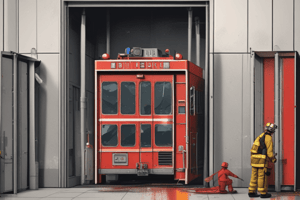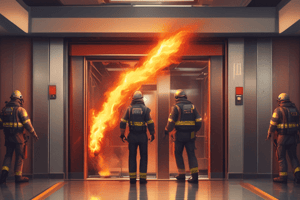Podcast
Questions and Answers
What should firefighters be prepared to do when smoke enters the elevator?
What should firefighters be prepared to do when smoke enters the elevator?
- Wait for orders from the incident commander
- Evacuate the building immediately
- Deactivate the elevator system
- Don their face pieces and move to the nearest stairway (correct)
What is the purpose of the 'Hold' function in the elevator?
What is the purpose of the 'Hold' function in the elevator?
- To prevent the elevator from moving
- To keep the doors open for longer
- To allow for safe entry of all personnel
- It will hold open the doors on that floor (correct)
Which statement best describes the role of the assigned firefighter in the elevator?
Which statement best describes the role of the assigned firefighter in the elevator?
- To ensure personal safety without operating the equipment
- To keep the elevator car in standby mode
- To monitor the fire conditions from the elevator
- One ff should be assigned to operate the car to ensure that later arriving units can use the car (correct)
Why is pre-incident planning emphasized in elevator operation?
Why is pre-incident planning emphasized in elevator operation?
What action should firefighters avoid when handling the elevator doors?
What action should firefighters avoid when handling the elevator doors?
What is a primary reason for not using elevators during a fire emergency?
What is a primary reason for not using elevators during a fire emergency?
Where must Knox boxes be located in buildings lacking 24-hour on-site security?
Where must Knox boxes be located in buildings lacking 24-hour on-site security?
What function does Fire Service Phase I serve for elevators?
What function does Fire Service Phase I serve for elevators?
Which keying action can be performed to reset elevators to normal service after alarms are cleared?
Which keying action can be performed to reset elevators to normal service after alarms are cleared?
In what situation can the 'BYPASS' key position be used?
In what situation can the 'BYPASS' key position be used?
What type of keys should be found in the Knox box according to the guidelines?
What type of keys should be found in the Knox box according to the guidelines?
What year did all elevators mandate a “call cancel” button on the cars control panel?
What year did all elevators mandate a “call cancel” button on the cars control panel?
What is indicated by the activation of Fire Service Phase I via a smoke detector?
What is indicated by the activation of Fire Service Phase I via a smoke detector?
What is the maximum number of firefighters allowed to use an elevator at one time?
What is the maximum number of firefighters allowed to use an elevator at one time?
Under what condition can fire department personnel exit an elevator on the fire floor?
Under what condition can fire department personnel exit an elevator on the fire floor?
What feature must elevators manufactured after 1991 include?
What feature must elevators manufactured after 1991 include?
What should firefighters do if an elevator loses power?
What should firefighters do if an elevator loses power?
Why should firefighters avoid ascending directly to the floor two floors below the fire?
Why should firefighters avoid ascending directly to the floor two floors below the fire?
What is one action firefighters should take as soon as the elevator begins to move from the lobby?
What is one action firefighters should take as soon as the elevator begins to move from the lobby?
What equipment must all crews entering an elevator be equipped with?
What equipment must all crews entering an elevator be equipped with?
What should firefighters do at the first sign of trouble when using an elevator?
What should firefighters do at the first sign of trouble when using an elevator?
What is necessary for Phase II operation to be activated?
What is necessary for Phase II operation to be activated?
What happens when the Phase II switch is keyed to 'HOLD'?
What happens when the Phase II switch is keyed to 'HOLD'?
Which condition allows the Investigation Group to use elevators during business fire alarms?
Which condition allows the Investigation Group to use elevators during business fire alarms?
What is the requirement for the company officer after removing the elevator service keys for business fire alarms?
What is the requirement for the company officer after removing the elevator service keys for business fire alarms?
In which situation is elevator use considered appropriate during a working fire?
In which situation is elevator use considered appropriate during a working fire?
Where should firefighters avoid taking an elevator during a fire situation?
Where should firefighters avoid taking an elevator during a fire situation?
What should be checked before using the elevator during a fire?
What should be checked before using the elevator during a fire?
What must responders do if smoke is reported on multiple floors when using an elevator?
What must responders do if smoke is reported on multiple floors when using an elevator?
What is NOT a way to accurately determine the fire floor?
What is NOT a way to accurately determine the fire floor?
What is NOT a condition where the investigation group can use the elevator for a business alarm?
What is NOT a condition where the investigation group can use the elevator for a business alarm?
No more than __ FFs are to use the elevator at one time
No more than __ FFs are to use the elevator at one time
All elevator cars manufactured after ___ must have a call cancel button on the cars control panel
All elevator cars manufactured after ___ must have a call cancel button on the cars control panel
Flashcards
Elevator Risks at Fires
Elevator Risks at Fires
Elevators present hazards during fires, including malfunctioning and exposure to fire, smoke, or superheated gases. Specific safety protocols must be followed when using elevators at fires.
What is a Knox Box?
What is a Knox Box?
A key-operated box containing essential keys for accessing elevator control systems and building interiors.
What is Fire Service Phase I?
What is Fire Service Phase I?
This phase, activated by key or smoke detectors, secures the elevator by returning it to a pre-determined floor and locking it to prevent normal use during a fire.
What is Fire Service Phase II?
What is Fire Service Phase II?
Signup and view all the flashcards
Elevator Use During Investigations
Elevator Use During Investigations
Signup and view all the flashcards
IC Authorizes Elevator Use
IC Authorizes Elevator Use
Signup and view all the flashcards
Elevator Safety Protocol - 1
Elevator Safety Protocol - 1
Signup and view all the flashcards
Elevator Safety Protocol - 2
Elevator Safety Protocol - 2
Signup and view all the flashcards
Elevator Safety Protocol - 3
Elevator Safety Protocol - 3
Signup and view all the flashcards
Elevator Safety Protocol - 4
Elevator Safety Protocol - 4
Signup and view all the flashcards
Elevator Safety Protocol - 5
Elevator Safety Protocol - 5
Signup and view all the flashcards
Elevator Usage Logging
Elevator Usage Logging
Signup and view all the flashcards
Firefighter Equipment for Elevator Use
Firefighter Equipment for Elevator Use
Signup and view all the flashcards
Using Fire Service Feature Elevators
Using Fire Service Feature Elevators
Signup and view all the flashcards
What is the 'Call Cancel' Button?
What is the 'Call Cancel' Button?
Signup and view all the flashcards
Forcible Entry Tools for Elevators
Forcible Entry Tools for Elevators
Signup and view all the flashcards
Emergency Stop Buttons and Precautionary Stops
Emergency Stop Buttons and Precautionary Stops
Signup and view all the flashcards
Arrival at Destination - 1
Arrival at Destination - 1
Signup and view all the flashcards
Arrival at Destination - 2
Arrival at Destination - 2
Signup and view all the flashcards
Elevator Operator Designation
Elevator Operator Designation
Signup and view all the flashcards
Elevator Operations and Pre-Incident Planning
Elevator Operations and Pre-Incident Planning
Signup and view all the flashcards
Elevator Use in Firefighting
Elevator Use in Firefighting
Signup and view all the flashcards
Understanding Elevator Features
Understanding Elevator Features
Signup and view all the flashcards
Elevator Use in Emergencies
Elevator Use in Emergencies
Signup and view all the flashcards
Teamwork and Coordination in Elevator Use
Teamwork and Coordination in Elevator Use
Signup and view all the flashcards
Safe and Efficient Elevator Use
Safe and Efficient Elevator Use
Signup and view all the flashcards
Study Notes
Elevator Operations at Working Fires
- Elevators can pose serious risks during fires, including malfunctioning and exposure to fire, smoke, or superheated gases.
- Specific precautions and procedures must be followed to ensure firefighter safety when utilizing elevators at fires.
Knox Box Requirements
- Knox boxes must be installed in buildings lacking 24-hour on-site security, located in the elevator lobby or outside the building.
- Required contents include elevator fire service keys and access keys to the building's interior, potentially including keys to the elevator mechanical room.
Fire Service Phase I
- Phase I is activated via a key at the hall station switch or automatically by smoke detectors.
- This phase secures the elevator, returning it to a predetermined landing and locking it to prevent normal use during a fire.
Fire Service Phase II
- Activation requires Phase I to be engaged; it allows elevator operation exclusively from the car station.
- The hall call buttons are disabled; the "HOLD" function can keep the car at a selected floor while open, preventing accidental movement.
Conditions for Business Fire Alarms
- Investigative teams may use elevators if the fire alarm panel has no multiple trips and they are trained in elevator operations.
- report the elevator car number, using companies, and the destination floor to the Incident Commander (IC).
Safety Protocols for Working Fires
- The Incident Commander (IC) may allow elevator use during working fires, subject to strict safety protocols.
- Avoid upper floors and ensure the elevator shaft is checked for smoke/fire damage before use.
- Verify the fire floor through observation or inquiries; exit the elevator at least two floors below smoke reports.
- Walk up if the fire is within five floors of the elevator lobby.
Operations Before Elevator Use
- Note the stairway location and distance before entering and limit elevator usage to six firefighters at a time.
- Exit the elevator if an "Under Control" signal has not been issued; lobby control should log all elevator usage details.
- Firefighters must wear full PPE and have SCBA, portable radios, and forcible entry tools.
Elevator Features and Emergency Protocols
- Only use Fire Service Feature elevators, equipped with "Call Cancel" buttons allowing immediate stopping before reaching a selected floor.
- In emergencies, have forcible entry tools ready to access the car doors.
- Utilize emergency stop buttons and perform precautionary stops every five floors to verify elevator function and stairway locations.
Arrival at Destination
- Upon reaching the destination, prepare to don face pieces and move towards the nearest stairway if smoke enters the car.
- Do not block the elevator doors; instead, use the hold function to secure the car while exiting.
- Designate a firefighter to operate the elevator for the efficient use of resources by later arriving units.
- Familiarize crew members with elevator operations and pre-incident planning to enhance response effectiveness.
Studying That Suits You
Use AI to generate personalized quizzes and flashcards to suit your learning preferences.



